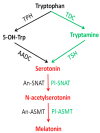Fundamental issues related to the origin of melatonin and melatonin isomers during evolution: relation to their biological functions
- PMID: 25207599
- PMCID: PMC4200856
- DOI: 10.3390/ijms150915858
Fundamental issues related to the origin of melatonin and melatonin isomers during evolution: relation to their biological functions
Abstract
Melatonin and melatonin isomers exist and/or coexist in living organisms including yeasts, bacteria and plants. The levels of melatonin isomers are significantly higher than that of melatonin in some plants and in several fermented products such as in wine and bread. Currently, there are no reports documenting the presence of melatonin isomers in vertebrates. From an evolutionary point of view, it is unlikely that melatonin isomers do not exist in vertebrates. On the other hand, large quantities of the microbial flora exist in the gut of the vertebrates. These microorganisms frequently exchange materials with the host. Melatonin isomers, which are produced by these organisms inevitably enter the host's system. The origins of melatonin and its isomers can be traced back to photosynthetic bacteria and other primitive unicellular organisms. Since some of these bacteria are believed to be the precursors of mitochondria and chloroplasts these cellular organelles may be the primary sites of melatonin production in animals or in plants, respectively. Phylogenic analysis based on its rate-limiting synthetic enzyme, serotonin N-acetyltransferase (SNAT), indicates its multiple origins during evolution. Therefore, it is likely that melatonin and its isomer are also present in the domain of archaea, which perhaps require these molecules to protect them against hostile environments including extremely high or low temperature. Evidence indicates that the initial and primary function of melatonin and its isomers was to serve as the first-line of defence against oxidative stress and all other functions were acquired during evolution either by the process of adoption or by the extension of its antioxidative capacity.
Figures




References
-
- Tan D.X., Hardeland R., Manchester L.C., Paredes S.D., Korkmaz A., Sainz R.M., Mayo J.C., Fuentes-Broto L., Reiter R.J. The changing biological roles of melatonin during evolution: From an antioxidant to signals of darkness, sexual selection and fitness. Biol. Rev. Camb. Philos. Soc. 2010;85:607–623. - PubMed
-
- Fuhrberg B., Hardeland R., Poeggeler B., Behrmann G. Dramatic rises of melatonin and 5-methoxytryptamine in Gonyaulax exposed to decreased temperature. Biol. Rhythm Res. 1997;28:144–150. doi: 10.1076/brhm.28.1.144.12978. - DOI
-
- Hardeland R., Pandi-Perumal S.R., Poeggeler B.M. Melatonin in plants—Focus on a vertebrate night hormone with cytoprotective properties. Funct. Plant Sci. Biotechnol. 2007;1:32–45.
Publication types
MeSH terms
Substances
LinkOut - more resources
Full Text Sources
Other Literature Sources
Molecular Biology Databases

